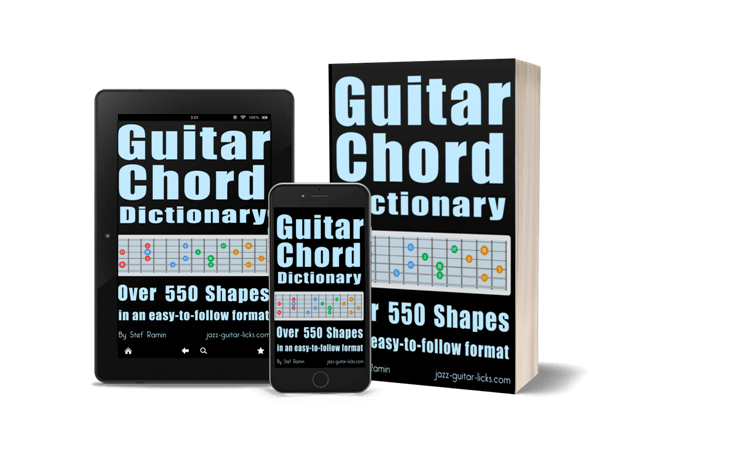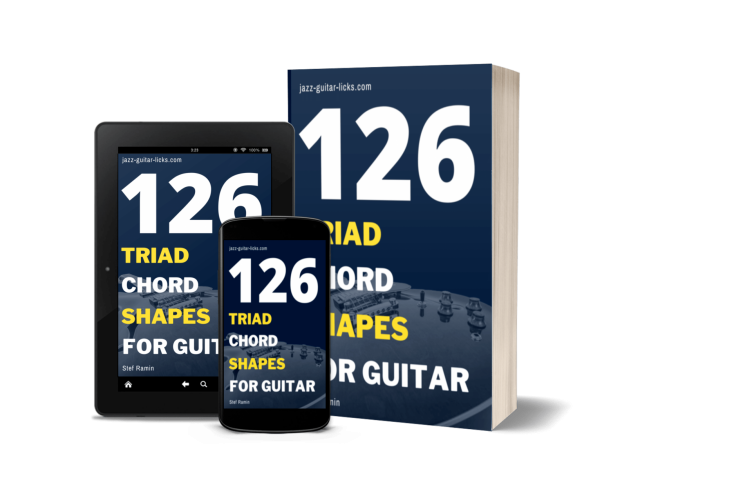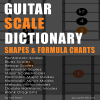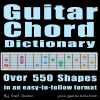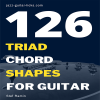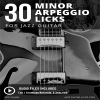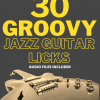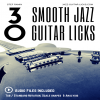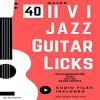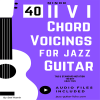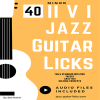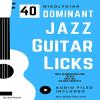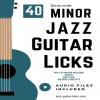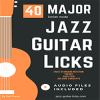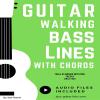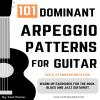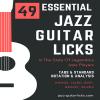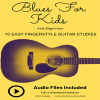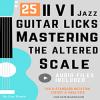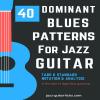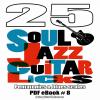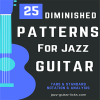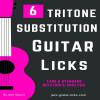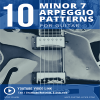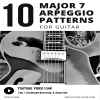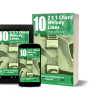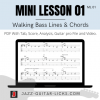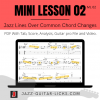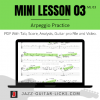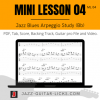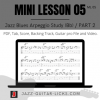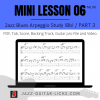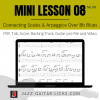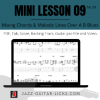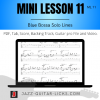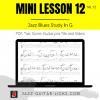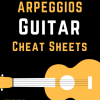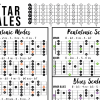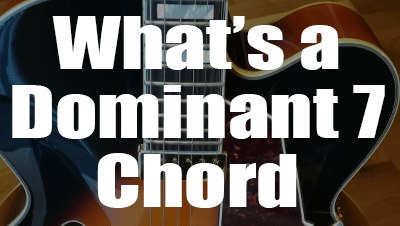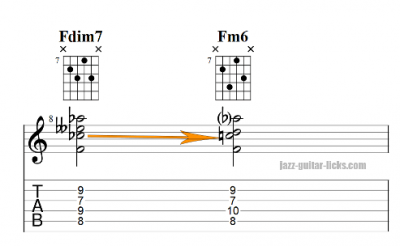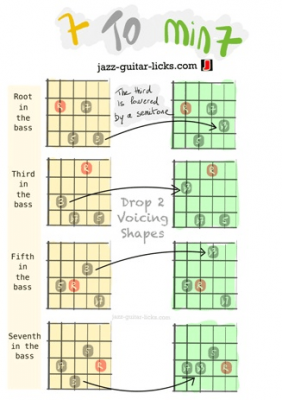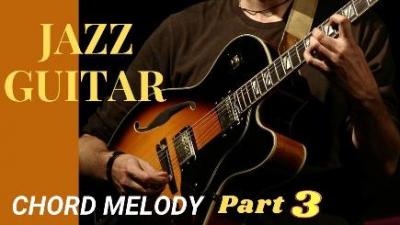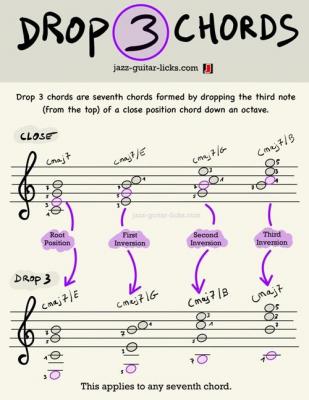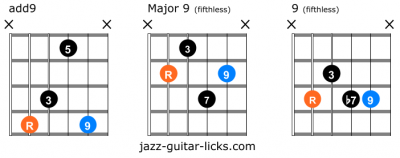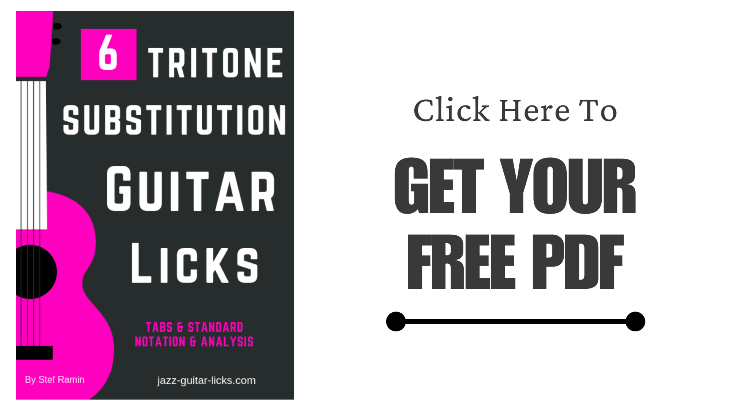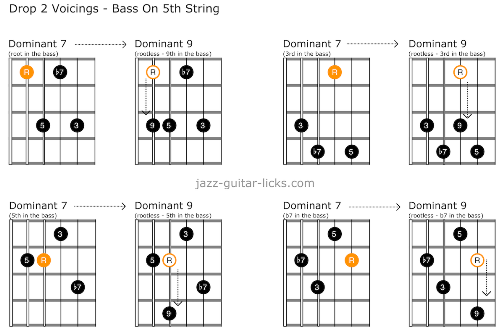
How To Turn A 7th Chord Into A Rootless 9th Chord - Theory Lesson For Guitarists
- By jazz-guitar-licks
- On 2023-02-15
- 2 comments
This chord theory lesson focuses on how to transform a dominant 7 chord (drop 2, drop 3 and related inversions) into a rootless ninth chord by replacing the tonic (1) with the ninth (9).
This technique will help guitarists expand their harmonic knowledge and also explore their neck in more depth. This can be a useful trick when composing or for chord melody arrangements.
What's A Dominant 7 Chord?
Dominant seventh chords have a very important role in jazz and blues music, they are the most versatile. Indeed, they accept a lot of extensions as 9, 11, 13 and also altered tones as b5, #9, b9, #11, b13.
Firstable, you need to know that dominant 7 chords are built on the basis of a major triad (R - 3 - 5). A minor seventh is added to this triad to get a dominant seventh chord, thus giving the interval formula R (root), major third (3), fifth (5) and minor seventh (b7). For example a C7 chord is made of C (R), E (3), G (5), Bb (b7).
| C7 | C | E | G | Bb |
| Intervals | R | 3 | 5 | b7 |
What's A Ninth Chord?
A ninth chord is seventh chord with a supplementary note, the ninth (9). There are three main types of ninth chords that are : Major ninth ( 1 - 3 - 5 - 7 - 9), minor ninth (1 - b3 - 5 - b7 - 9) and dominant ninth (1 - 3 - 5 - b7 - 9).
Even if the following technique works for any type of ninth chord, we will take the dominant 9 chord as example. As shown in the chart below, to create a dominant ninth chord from a dominant seventh chord, just add the ninth (D in the example).
| C7 | C | E | G | Bb | X |
| C9 | C | E | G | Bb | D |
| Intervals | 1 | 3 | 5 | b7 | 9 |
What's A Rootless Chord Voicing?
The answer is in the question. A rootless chord is simply a chord whose root as been removed.
How To Build A Rootless 9th Chord From A 7th Chord?
To build rootless dominant 9 chords, just remove the root of a dominant seventh chord and replace it by the 9th. Remember that it works for any type of seventh chord (minor 7 to rootless min9 and major 7 to rootless major 9 for example)
Rootless Dominant 9 Guitar Chord Shapes (drop 2)
Here are four dominant 9 guitar chord shapes built from four drop 2 dominant 7 voicings (1 root position and 3 inversions) with bass notes on low E string. R being the root note, 3 the major third, 5 the perfect fifth and b7 the minor seventh.
The root of the 7th chord is simply raised by a whole step to get the 9th of the dominant 9 chord.
This summary table show the interval formulas related to the next guitar neck diagrams.
| Dominant 7 (root in the bass) | R | 5 | b7 | 3 |
| Dominant 9 (9 in the bass) | 9 | 5 | b7 | 3 |
| Dominant 7 (3 in the bass) | 3 | b7 | R | 5 |
| Dominant 9 (3 in the bass) | 3 | b7 | 9 | 5 |
| Dominant 7 (5 in the bass) | 5 | R | 3 | b7 |
| Dominant 9 (5 in the bass) | 5 | 9 | 3 | b7 |
| Dominant 7 (b7 in the bass) | b7 | 3 | 5 | R |
| Dominant 9 (b7 in the bass) | b7 | 3 | 5 | 9 |
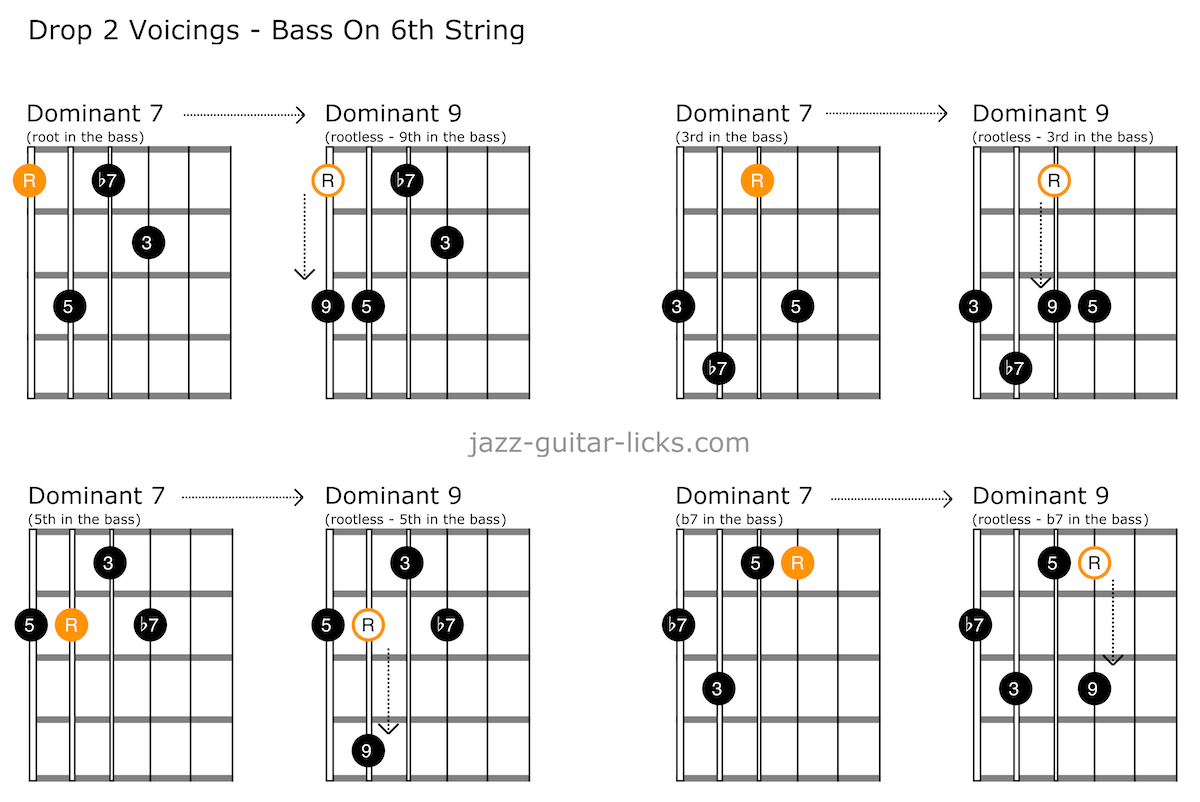
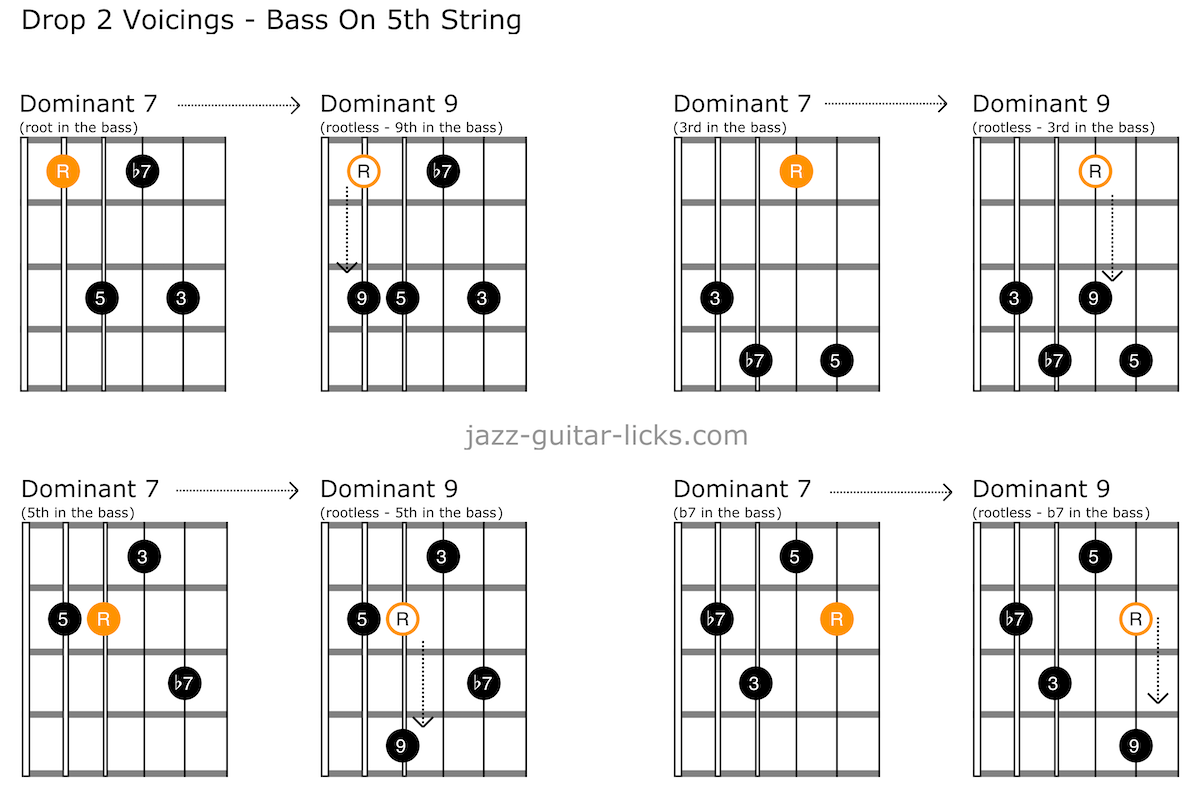
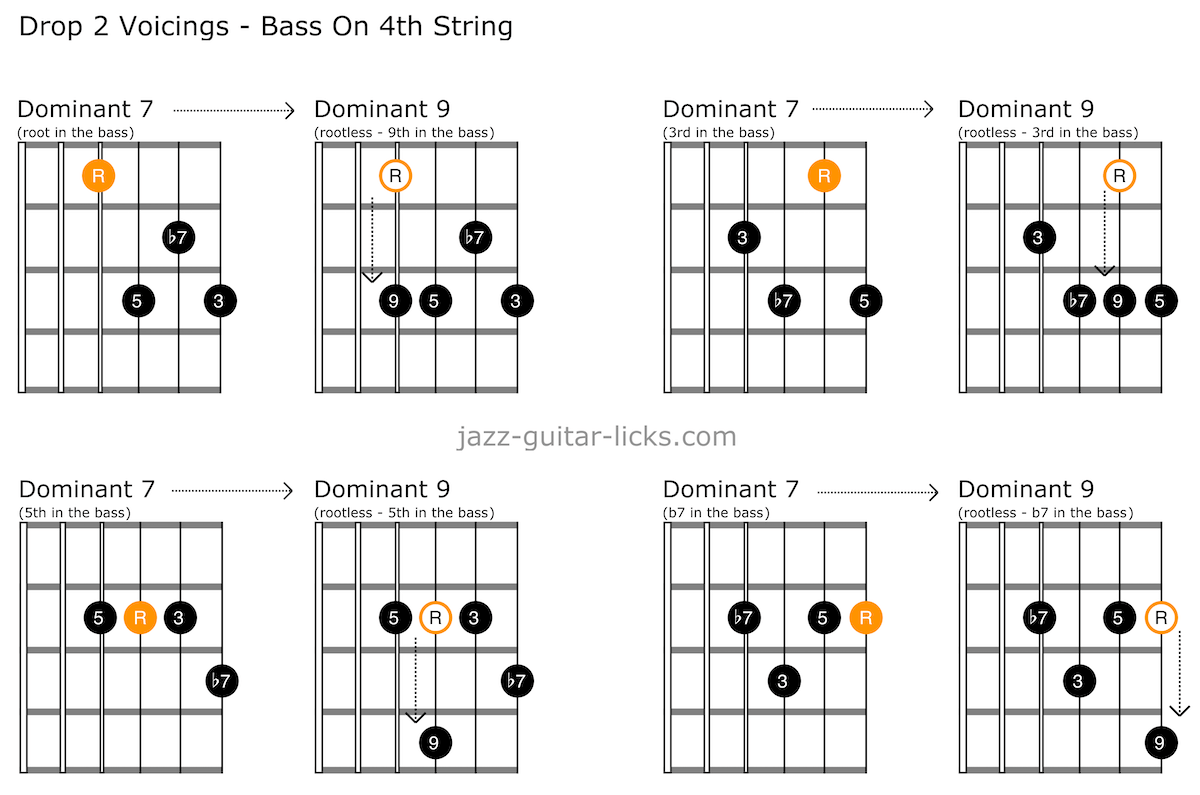
Rootless Dominant 9 Guitar Chord Shapes (drop 3)
Let's tackle the dominant 9 chords based on the drop 3 dominant 7 shapes. You'll find below a recapitulative chart and the related guitar chord shapes with bass notes on the low E string.
| Dominant 7 (root in the bass) | R | b7 | 3 | 5 |
| Dominant 9 (9 in the bass) | 9 | b7 | 3 | 5 |
| Dominant 7 (3 in the bass) | 3 | R | 5 | b7 |
| Dominant 9 (3 in the bass) | 3 | 9 | 5 | b7 |
| Dominant 7 (5 in the bass) | 5 | 3 | b7 | R |
| Dominant 9 (5 in the bass) | 5 | 3 | b7 | 9 |
| Dominant 7 (b7 in the bass) | b7 | 5 | R | 3 |
| Dominant 9 (b7 in the bass) | b7 | 5 | 9 | 3 |
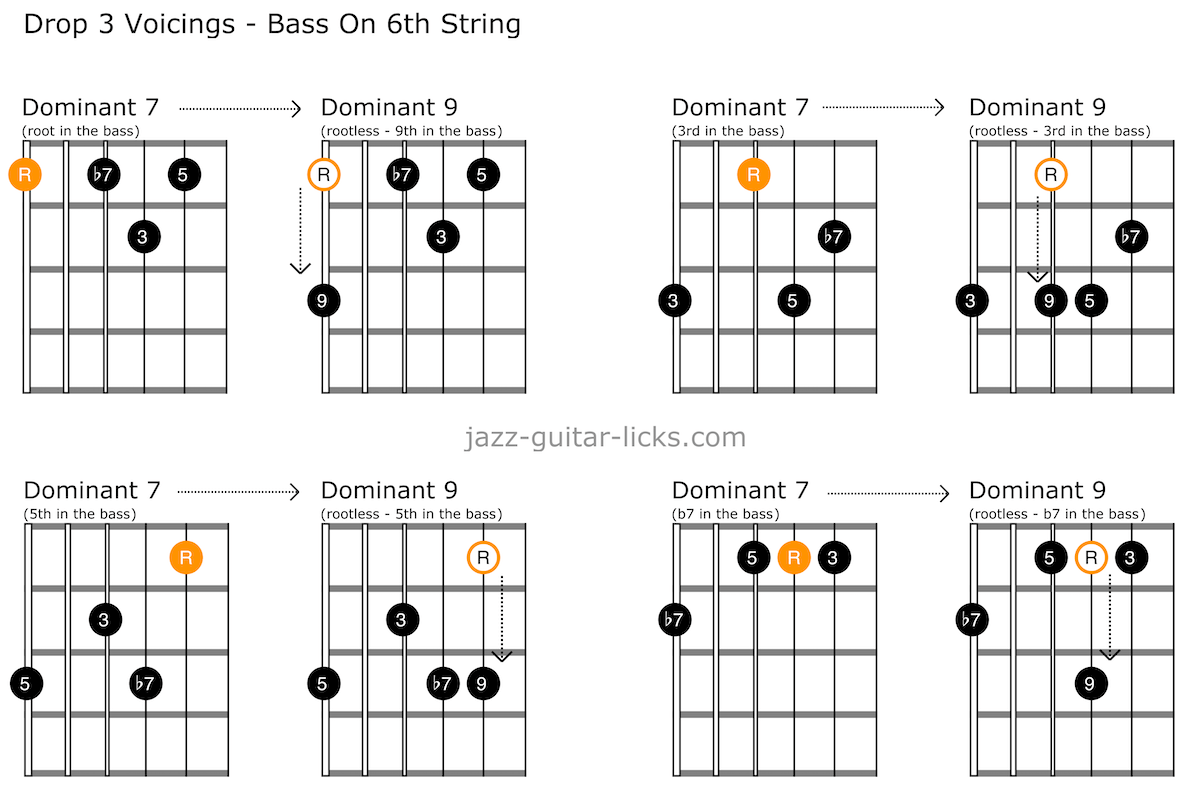
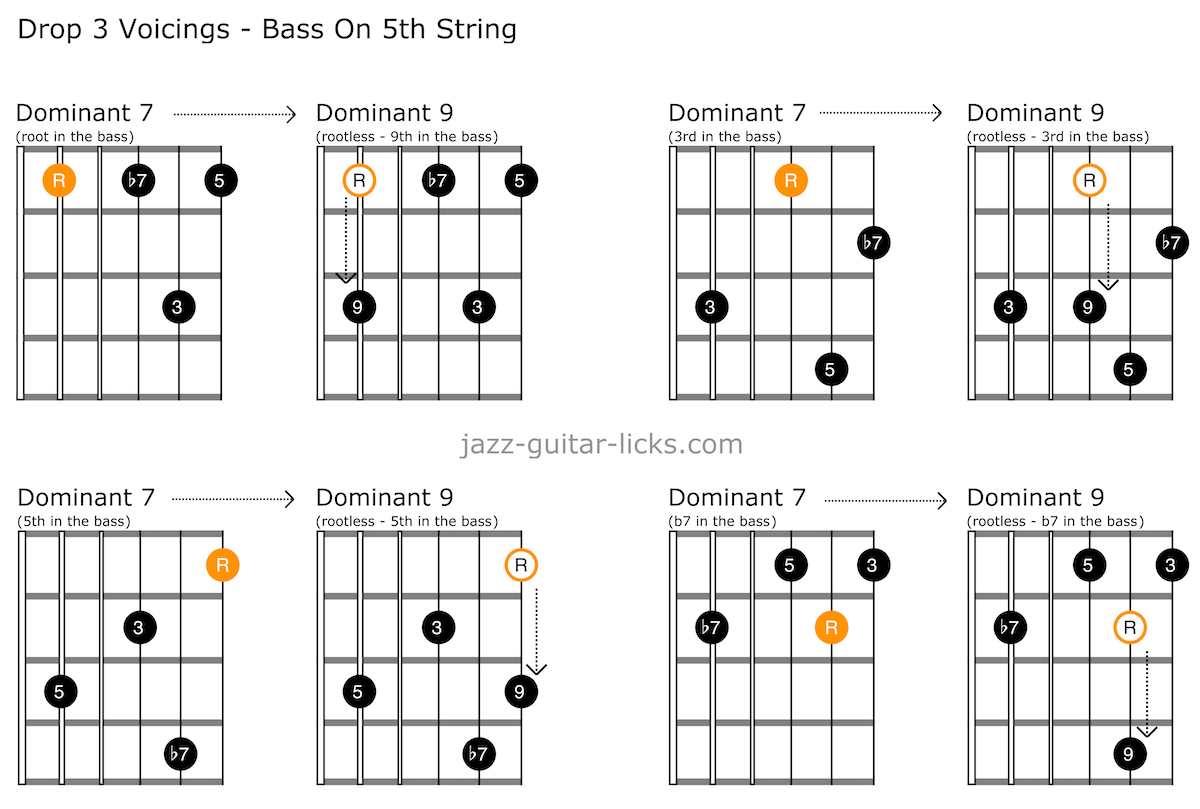
Comparison With Half-diminished Chords
One interesting thing which can be useful for chord substitution is that rootless dominant 9 chords shapes are actually the same as half-diminished (m7b5).
For example you can see and hear that a m7b5 chord with root in the bass is the same form as rootless dominant 9 chord with major third (3) in the bass.
Here are eight shapes to illustrate this theory, which applies to any drop 2 or drop 3 half-diminished chord.
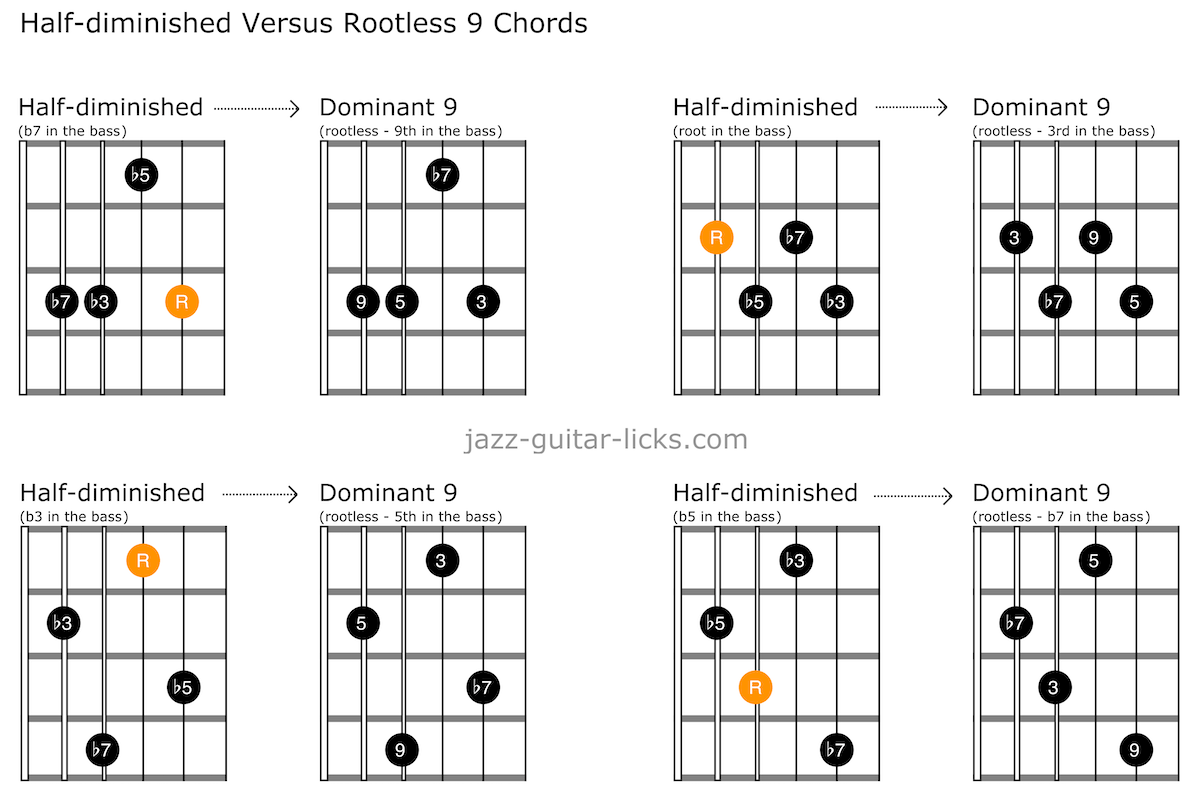
Comparison With minor 6 Chords
Rootless dominant 9th chord shapes can also be compared with minor 6 shapes. Let's take the minor 6 shape with the root in the bass, you see that it is actually a rootless dom9 chord with 5th in the bass.
This applies to any m7b5 drop voicings. So try to make the conversion and find the positions on the guitar.
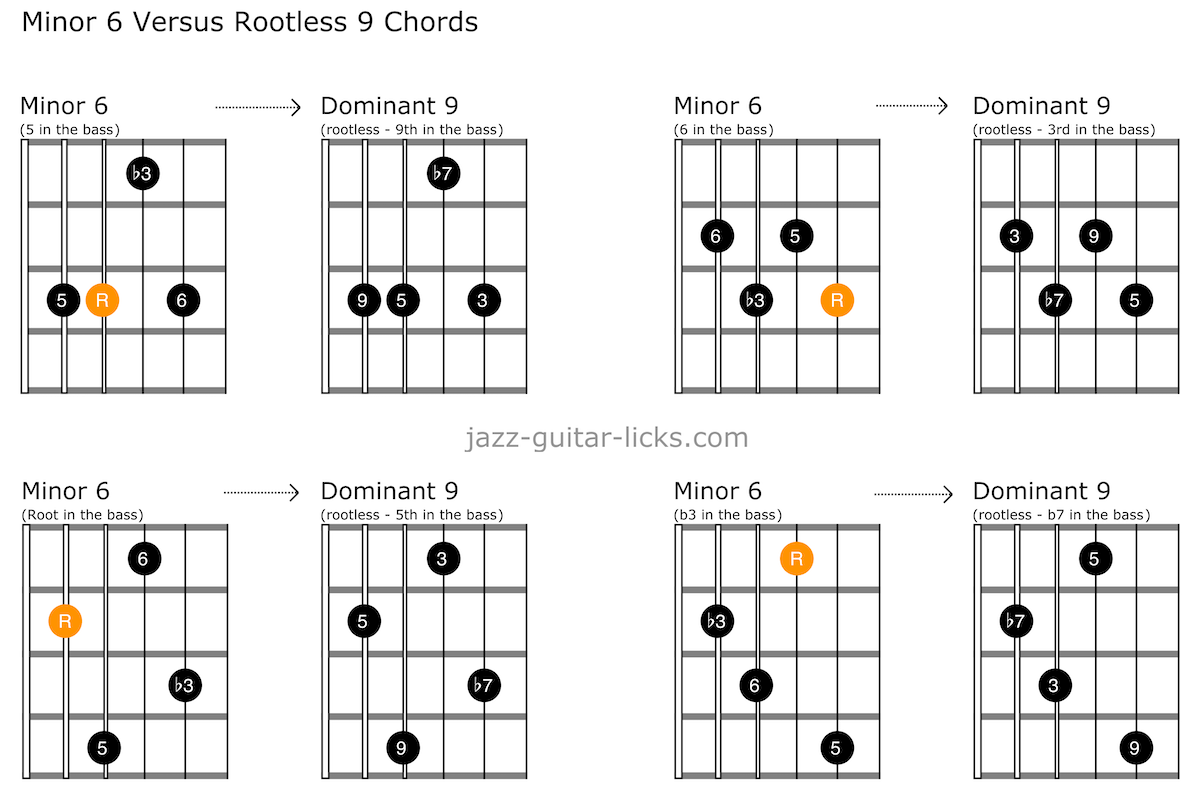
-
Guitar Scale Dictionary
This E-book is a printable PDF method including over 700 scale diagrams and formula charts for guitarists. -
Guitar Chord Dictionary
This PDF eBook provides over 550 guitar chord shapes. This is the perfect reference guide to understand how chords are built and how to play them on the guitar neck. -
172 Arpeggio Shapes For Guitar
This printable PDF is a method dedicated to guitarists of all styles who want to learn build and play the most important types of arpeggios. -
126 Triad Chord Shapes
This handbook for guitar players is intended both for teachers and students. It includes 126 guitar shapes for mastering triads. -
Harmonic Major Scale Chords
this PDF offers diagrams and tabs for guitar to learn the chords of the harmonic major scale. -
Major Scale Harmonization
This package provides a printable PDF with exercises and audio files to learn how to harmonize the major scale with 3 note chords and their extensions. -
30 Minor Arpeggio Licks
This package includes a printable PDF method containing 30 exercises with tabs, staves and audio files for practicing minor arpeggios on guitar. -
II V I Bundle - 170 Exercises
This bundle contains 4 PDF methods for a total of 170 exercises with tabs, staves, analysis & audio files for practicing scales, arpeggios licks & chords over the 2-5-1 progression. -
Diatonic Licks Bundle
This package contains 120 jazz guitar lines based on diatonic modes as Mixolydian, Dorian and Ionian. PDF format with tabs, audio files and analysis. -
30 Groovy Jazz Guitar Licks
This downloadable package contains a PDF WITH audio files giving access to 30 groovy guitar phrases mixing jazz, blues and funky licks for beginners. -
30 Smooth Jazz Guitar Licks
In this package you'll get a printable PDF Method with tabs, notation, analysis, scale shapes and audio files for practicing 30 smooth jazz guitar licks. -
40 II V I Jazz Guitar Licks
This pdf method for guitar contains fourteen 2 5 1 jazz guitar lines with tab, standard notation, analysis, scale charts and audio files. -
50 II-V-I voicings
This printable PDF guitar method provides 50 exercises with audio files, analysis, tab and staves for learning major 2-5-1 chord voicings. -
40 Minor 2 5 1 Chord Voicings
This PDF method contains 40 exercices with tabs, scores and audio files for practicing jazz guitar chords over the minor 2 5 1 progression. -
40 Minor II V I Licks
This guitar method is a printable PDF with tabs, diagrams, theory and audio files providing 40 minor 2 5 1 jazz patterns. -
40 Mixolydian Jazz Guitar Lick
PDF guitar method with tabs, audio files and theory providing 40 dominant jazz guitar lines for teachers and students. -
40 Minor Jazz Guitar Licks
This printable guitar method in PDF format contains 40 easy minor jazz guitar lines based on the Dorian mode. -
40 Major Jazz Guitar Licks
Printable PDF eBook method containing 40 major jazz guitar licks with tab, standard notation and audio files for beginners and intermediates. -
Guitar Walking Bass Lines
This jazz guitar method about walking bass lines and chords is available as a PDF files containing 35 exercises with tabs, analysis and audio files -
101 Dominant Arpeggio Patterns
This printable PDF method provides 101 dominant arpeggio exercises with tab, theory and standard notation for the jazz, blues and rock guitarist. -
49 Essential Jazz Lines
This printable eBook method in PDF format provides 49 jazz solo transcriptions of the greatest jazz musicians. Tab, standard notation, audio files & analysis. -
11 Jazz Blues Studies
11 jazz blues chord studies with tabs, standard notation, analysis, and audio recordings and PDF. -
10 Easy Fingerstyle Blues
This PDF with Tabs and audio files provides 10 easy acoustic fingerstyle blues guitar studies for kids and beginners. -
25 Altered Jazz Guitar Lines
This PDF eBook method contains 25 altered jazz guitar licks with tabs, patterns, scale charts and audio files to master, apply and develop the altered scale. -
40 Blues Dominant Patterns
This printable method is available as a PDF file containing 40 easy dominant jazz-blues guitar lines with tabs, standard notation, analysis, audio files and scale charts. -
25 Pentatonic Licks
This jazz guitar method is an eBook available as a PDF with standard notation, guitar tabs, diagrams, analysis, audio files and backing tracks. You will find in this booklet 25 easy jazz guitar lines with theory using common and rare pentatonic scales. -
25 Soul Jazz Guitar Licks
You will find here an eBook available in PDF containing 25 soul jazz and hard bop guitar licks in the style of Grant Green, Melvin Sparks, George Benson. -
25 Diminished Patterns
This eBook PDF with audio files contains 25 dominant diminished jazz guitar patterns using the half-whole diminished scale and diminished 7th arpeggios. -
6 Tritone substitution licks
This Printable PDF eBook available for free download contains 6 easy jazz guitar licks with tabs/notation, youtube video link and analysis about the tritone substitution. -
10 Minor 7 Arpeggio Patterns
This printable PDF eBook offers 10 easy minor 7 arpeggio patterns with its related YouTube video for beginner guitarists. -
10 Easy Major 7 Arpeggio Licks
This is a printable PDF for beginner jazz guitar players providing 10 easy licks to practice major 7 arpeggios. -
10 Chord Melody Lines
Within this package, you'll discover a set of ten chord melody exercises for beginners. Printable PDFaudio files, a backing track, and a link to the associated YouTube video. -
10 Minor Blues Scale Licks
You'll find here a PDF with 10 easy jazz guitar licks to practice the minor blues scale on guitar.
-
Mini Lesson 01 (ML 01)
You'll find a mini guitar lesson about walking bass lines and chords containing a PDF with tab, score analysis, shapes, a video and a guitar pro file. -
Mini Lesson 02 (ML 02)
In this mini jazz guitar lesson you will learn how to play easy and cool jazz lines over basic chord changes found in jazz. Pdf, tab and video included. -
Mini Lesson 03 (ML 03)
With this short lesson you will learn how to play and connect basic guitar arpeggios over a diatonic chord progression. -
Mini Lesson 04 (ML 04)
This is a downloadable package with PDF, Tab, guitar pro file and video to practice guitar arpeggios over a jazz blues chord progression. -
Mini Lesson 05 (ML 05)
This downloadable package provides a PDF with Tab/score, a guitar pro file and a short video for practicing guitar arpeggios on a jazz blues progression in Bb. -
Mini Lesson 06 (ML 06)
This package for guitarists contains a PDF with tab, video, backing track and guitar pro file for practicing arpeggios over a basic jazz blues progression. -
Mini Lesson 07 (ML 07)
With this mini guitar lesson you will learn how to superimpose arpeggios over a diatonic chord progression. Video, pdf, jamtrack and guitar pro file included. -
Mini Lesson 08 (ML08)
Mini lesson with PDF, guitar pro file, video and backing track for practicing scale and arpeggio connections over a Bb jazz blues progression. -
Mini Lesson 09 (ML09)
This mini lesson is a downloadable package containing a PDF, video, backing track and guitar pro file of a jazz blues progression study in B. -
Mini Lesson 10 (ML 10)
This mini guitar lesson provides a printable PDF with tab/notation, video, backing track and guitar pro file for practicing open triads over Fly Me To The Moon. -
Mini Lesson 11 (ML 11)
This guitar lesson is a package inlcuding a PDF transcription with analysis, a short video, a backing track and a guitar pro file to learn to play jazz solo lines over Blue Bossa. -
Jazz Blues Guitar Study (ML12)
This mini lesson provides a video, a guitar pro file and PDF transcription of a jazz blues study in G implying melodic lines, chord extensions and substitutions
-
Downloadable and printable music cheat sheets for guitar teachers and students.
-
Educational and decorative guitar posters and wall art for students and instructors. Scales, chords, licks, arpeggios, triads and music theory.
chords voicings Theory dominant 7 chords ninth chords
Comments
-

- 1. Brian On 2023-04-20
Hi,
54 year old OCD hard knowledge seeking person here. I always complete my projects and assignments that are realistic.
quick summary as I am rather long winded: I started playing at age 19 have natural tendency to soloing/Melody weaker on understanding of Chords/harmony. I played around a few years later had guitar equipment stolen. I just now bought acoustic Taylor and electric fender.
I have been studying some online courses its started clicking about harmony is just same really as a melody and you can play harmony in scales just like a melody. online stuff was great but then he departed from theory and I as an engineer and seeker of knowledge was bothered by this. He had started using Minor 7th flat 5th chords on the 7th chord for the 7th note in the scale/chord progression instead of the dim that he had used on the triads. This was fine except I wanted technical reasons I have desire to learn and understand things. This is not just for music this is for everything in life its just who I am.
This brought me to a google search which led me to your pages and you used some term called drop chords but basically you explained what a dim 7th was: https://www.jazz-guitar-licks.com/pages/chords/diminished-seventh-chords.html
I then saw all these pages and as a learner was overwhelmed because to me knowledge is legacy and is precious and you built all this out so donated 10 bucks to your website from my paypal probably listed under my email:
Thanks for donating $10.00 USD to
Stef Ramin (Jazz Guitar Licks)
I really wanted to thank you for this but also I was wondering if there is method to learning sequentially? Meaning there is so much information that its a bit overwhelming as you have put years of work into this.
I want to have Mastery of music theory and the guitar not saying I want to be some Master of the guitar which I do of course but I am more realistic in that I am ok with being decent guitarist but mentally I want to have full Mastery if my timing is a bit sloppy or my strumming or I make quite a few mistakes thats fine but I want understanding.
is there like a course or lessons or something that I can follow in order here in my learning in sequential order? from your site. I would like to have structure so I can work on this and achieve goals with efficiency.
In any case great site as a scholar and scientist and seeker of knowledge I really appreciate what you have done here as sharing knowledge is very important as noted I see it as as legacy that lives on past us to anyone we touch with it so thanks again!-
- jazz-guitar-licksOn 2023-04-20
Hello Brian, Thanks for the donation. I can't really know your guitar level but as a beginner you should start by learning : - Basic triads (maj, min, dim, aug), basic positions first , then inversions. - Basic arpeggios (maj7, min7, 7, m7b5 and dim7). These are important basic tools to learn how chords are built and very useful for improvisation. - Basic scales as Major (Ionian, Dorian, Mixolydian, pentatonics, etc...) - Common progressions as major and minor 251, turnarounds. (solo and chords). - Jazz standards where you can apply all that is listed above. There is a lot of articles, mini lessons and PDF, check the search bar at the top of the website. Thanks Stef
Add a comment
